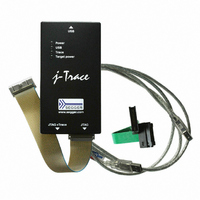8.10.00 J-TRACE ARM Segger Microcontroller Systems, 8.10.00 J-TRACE ARM Datasheet - Page 39

8.10.00 J-TRACE ARM
Manufacturer Part Number
8.10.00 J-TRACE ARM
Description
JTAG EMULATOR ARM7/ARM9 ETM
Manufacturer
Segger Microcontroller Systems
Type
Emulatorr
Specifications of 8.10.00 J-TRACE ARM
Contents
Emulation Module
For Use With/related Products
ARM7, ARM9
Lead Free Status / RoHS Status
Lead free / RoHS Compliant
Other names
899-1006
- Current page: 39 of 222
- Download datasheet (3Mb)
1.6
1.6.1
1.6.2
J-Link / J-Trace (UM08001)
In general, there are two ways two ways to support a CPU-core in the J-Link soft-
ware:
1.
2.
Having the intelligence in the firmware is ideal since it is much more powerful and
robust. The J-Link PC software automatically detects which implementation level is
supported for the connected CPU-core. If Intelligence in the firmware is available, it
is used. If you are using a J-Link does not have intelligence in the firmware and only
PC-side intelligence is available for the connected CPU, a warning message is shown.
On newer J-Links, the intelligence for a new CPU-core is also available in the J-Link
firmware which means, for these J-Links the target sequences are no longer gener-
ated on the PC-side but directly inside the J-Link. Having the intelligence in the firm-
ware leads to improved stability and higher performance.
This is the basic implementation level for support of a CPU-core. This implementation
is not J-Link model dependend, since no intelligence for the CPU-core is necessary in
the J-Link firmware. This means, all target sequences (JTAG/SWD/...) are generated
on the PC-side and the J-Link simply sends out these sequences and sends the result
back to the DLL. Using this way of implementation also allows old J-Links to be used
with new CPU cores as long as a DLL-Version is used which has intelligence for the
CPU.
But there is one big disadvantage of implementing the CPU core support on the DLL-
side: For every sequence which shall be send to the target a USB or Ethernet trans-
action is triggered. The long latency especially on a USB connection significantly
affects the performance of J-Link. This is true especially, when performing actions
where J-Link has to wait for the CPU frequently. An example is a memory read/write
operation which needs to be followed by status read operations or repeated until the
memory operation is completed. Performing this kind of task with only PC-side intel-
ligence will have to either make some assumption like: Operation is completed after
a given number of cycles or will have to make a lot of USB/Ethernet transactions. The
first option (fast mode) will not work under some circumstances such as low CPU
speeds, the second (slow mode) will be more reliable but very slow due to the high
number of USB/Ethernet transactions. It simply boils down to: The best solution is
having intelligence in the emulator itself!
Built-in intelligence for supported CPU-cores
Intelligence in the J-Link firmware
Intelligence on the PC-side (DLL)
Intelligence in the J-Link firmware
Intelligence on the PC-side (DLL)
© 2004-2011 SEGGER Microcontroller GmbH & Co. KG
39
Related parts for 8.10.00 J-TRACE ARM
Image
Part Number
Description
Manufacturer
Datasheet
Request
R

Part Number:
Description:
CONNECTOR JTAG-ARM ISOLATION
Manufacturer:
Segger Microcontroller Systems
Datasheet:

Part Number:
Description:
ADAPTER ARM TARGET 14PIN RIBBON
Manufacturer:
Segger Microcontroller Systems
Datasheet:

Part Number:
Description:
JTAG EMULATOR FOR ARM CORES
Manufacturer:
Segger Microcontroller Systems
Datasheet:

Part Number:
Description:
JTAG EMULATOR FOR ARM CORES
Manufacturer:
Segger Microcontroller Systems
Datasheet:

Part Number:
Description:
PROGRAMMING TOOL FOR MCU
Manufacturer:
Segger Microcontroller Systems
Datasheet:

Part Number:
Description:
PROGRAMMING TOOL FOR ST7 MCU
Manufacturer:
Segger Microcontroller Systems
Datasheet:

Part Number:
Description:
PROGRAMMING TOOL FOR STM8
Manufacturer:
Segger Microcontroller Systems
Datasheet:

Part Number:
Description:
PROGRAMMER JTAG FOR ARM CORES
Manufacturer:
Segger Microcontroller Systems
Datasheet:

Part Number:
Description:
JTAG EMULATOR USB ETHERNET ARM
Manufacturer:
Segger Microcontroller Systems
Datasheet:

Part Number:
Description:
EMULATOR JTAG/SWD CORTEX M3
Manufacturer:
Segger Microcontroller Systems
Datasheet:










